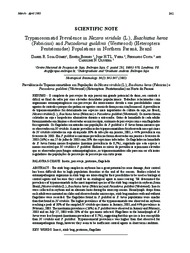Trypanosomatid prevalence in Nezara viridula (L.), Euschistus heros (Fabricius) and Piezodorus guildinii (Westwood) (Heteroptera: Pentatomidae) populations in Northern Paraná, Brazil.
Trypanosomatid prevalence in Nezara viridula (L.), Euschistus heros (Fabricius) and Piezodorus guildinii (Westwood) (Heteroptera: Pentatomidae) populations in Northern Paraná, Brazil.
Author(s): SOSA-GÓMEZ, D. R.; BORGES, E.; VIEIRA, I. H. T. L.; COSTA, F.; OLIVEIRA, C. N.
Summary: The stink bug complex in soybeans has a great potential to cause damage, their control has been difficult due to high population densities at the end of the season. Studies related to entomopathogenic organisms in stink bugs are interesting for their possibilities to be used as biological control agents and because they could be an etiological agent in mass rearing. We determined the prevalence of trypanosomatids in the most important species of the stink bugs complex in soybean, from Brazil, Nezara viridula (L.) Euschistus heros (Fabricius) and Piezodorus guildinii (Westwood). Insects were collected in soybean and on alternate hosts during the intercrop season. Hemolymph drops fromeach adult were mounted on slides and observed under microscope: stink bug numbers with and without flagellates were recorded. The flagellates found in P. guildinii or E. heros populations were smaller than that found in N. viridula. The higher prevalence of the trypanosomatids was observed on soybean reaching a peak of 30% of the sampled N. viridula specimens in January, 2001, and 44% prevalence in February, 2003. The maximum prevalences (16%) in P. guildinii were observed in January and February, 2003 and on July 27, 2003 with 20% of the specimens infected. Flagellates in the hemolymph of E. heros were less frequent (maximum prevalence of 8.7%), suggesting that this species is less susceptible than N. viridula and P. guildinii. Trypanosomatid prevalence was higher than that observed for entomopathogenic fungi, however they seem to be inefficient control agents in short term condition.
Publication year: 2005
Types of publication: Journal article
Unit: Embrapa Soybean
Keywords: Inseto, Percevejo, Praga de Planta, Soja
Observation
Some of Embrapa's publications are published as ePub files. To read them, use or download one of the following free software options to your computer or mobile device. Android: Google Play Books; IOS: iBooks; Windows and Linux: Calibre.
Access other publications
Access the Agricultural Research Database (BDPA) to consult Embrapa's full library collection and records.
Visit Embrapa Bookstore to purchase books and other publications sold by Embrapa.

